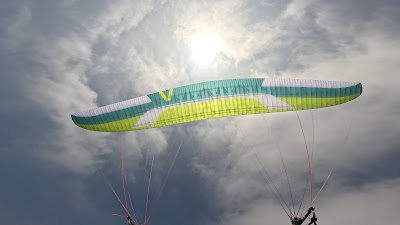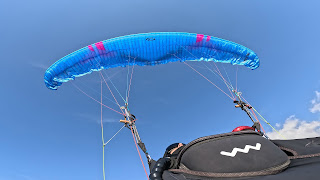Disclaimer:
Please note again… that tests will always differ with other sizes. At first, if flown with seatless harnesses, or must I say a completely different harness. Also if the same sizes are flown at different loads, lighter loads will get the weakest climb but will be penalized in control in heavy air or pushing through a heavy airmass. Bigger sizes have more gliding performance and also better climb in weak conditions. In my small tests, I always state the size, the total flying weight, and afterward IMHO, the optimum weight I found in that particular glider.
SUPAIR Step X size M flown from 93 to 97 all up.
The Step X is the new 2023 high EN-B from Supair. I will let you visit their website for the construction details and materials. https://supair.com/en/produit/aile-parapente-supair-en-b-step-cross/
The Step X has an aspect ratio of 5.65 made with Dominico, has 3 rows of lines, and the overall weight of the M size is around 4.3 kg with very nice construction details!
It is a relatively light EN-B and launches easily without any wind without any hard point. A straightforward glider to launch. In the stronger breeze, I didn’t find any nervousness or dynamic surges, but a smooth and easy-to-launch glider.
I flew the Step X at 97 all up in one turbulent very strong day, in our Cedars range (Explained down below)
Comfort and accessibility.
I found that the Step-X managed well all the harsh conditions without any tip fluttering, and still delivered a very prompt brake authority for the pilot to stay in control. Alternating flights and test flying the Mentor 7, I think that the Step-X is also a highly comfortable glider for that category! I was really surprised by the educated feedback and balanced movements of the Step-X in overall conditions. The Step X has slightly more feel than the Mentor 7 while remaining very comfortable to fly. To place it even further, I think it resembles the Swift 6 accessibility for the same size.
Handling and agility:
The brake length on the Step X is slightly longer than the Mentor 7 and slightly less than the Swift 6, which place it in the sweet spot. You need just around 15 to 20 cm to steer the glider after the first 10 cm gap.
The Step X is quite an agile glider and coring tight thermals are easily doable. The pressure is on the moderate side with its effective brake range to control the surges in active air, and flying it for hours is not tiring for the arms.
While the Maestro 2 could deliver more dynamic handling, the Step X is close in agility while being more user-friendly for the new high B pilot in that class, and calmer in thermals while coring every bit of lift.
Climb rate:
I flew next to higher-rated 2-liner C class gliders in thermals, and the climb rate in weak thermals was very good on Step X around 95 all up. It floats well! For real, this glider climbs very well comparing it with the B class.
It is for sure slower to enter the airmass as the 2 liners but for a high B with 3 lines, it climbs extremely well!
Gliding through the moving airmass and comparing it to other high B’s the Step X showed me also that it matches the best ones out there! Usually, when a glider has fewer lines like 2.5 ..etc..they should glide more, but flying the Step X near, I didn’t notice any disadvantages… What can I say…when a new creation seems really good and competitive! I was impressed!
I will update my B comparison for the little details in climb and glide, but I confirm that the Step X has a very efficient glide through the airmass for the high B category.
The speed bar has a moderate pressure, and the C steering has acceptable efficiency while on the bar for the 3 liners glider. Perhaps the Maestro 2 and the Rush 6, have swifter C controls, but nevertheless, the Step C controls are manageable and easy to use to control the overall movements.
The top speed is around 12 km/h over trim.
Ears are stable and reopen without pilot intervention.
Conclusion:
The Step X can be flown easily at 93 all up but it would be slow to enter the airmass. I found out at 95 to be nice overall, and to be even more efficient and more compact with good penetration fly it at 97,98.
When a product is nice, readers are expecting the testers to find the negative points, when they are difficult to find… My B comparison will shortly be updated.
Easily placed among the high B’s in terms of good overall performance, the Step X is an enjoyable glider to fly while being well-balanced and quite comfortable during long XCs. The passive safety seems quite high for that category delivering a solid and light-to-carry companion for your adventures. Supair never stopped to amaze me… It would be quite an interesting high B to test fly!
Cedars range:
Cedars range divides the country in half horizontally from north to South. The peaks are facing east and west. They reside above the very hot Bekaa Valley, situated inland of the country. If the thermal breeze is from the west, you will get nice conditions, but if it comes from the east, which it always does afternoon, then the challenge arises especially at noon, and preferable to fly only hang gliders as the very strong breeze literally limit your forward speed with sudden powerful thermals, and since taking off from the east side, a mix of strong valley east breeze and southwesterly wind coming from the sea side toward inland makes the word turbulence a bit undermined …
When I fly gliders there, I often feel many times I’m just a puppet underneath even on the easiest glider! Not a good feeling as sometimes, the workloads are extreme and need lots of endurance over the time spent and quite tiring. At 11 am +6 m/s thermals are common, with a high cloud base over 4500 m, but since there’s a commercial flight line passing over from 4000 m and up, so controlling your height is also very crucial!
Flying 2 hours from sunset to dark is the best experience a pilot would have. Smooth lift everywhere with a high cloud base.




























